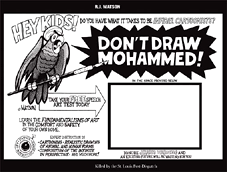

My friend David Wallis has just published a totally amazing anthology: Killed Cartoons. It’s a collection of dozens of cartoons that were killed by newspaper editors who were worried, as David writes, about offending “advertisers, the publisher’s golf partners, the publisher’s wife, the local police chief or the president of the United States, blacks, Asians, Hispanics, homophobes, gays, pro-choice advocates and anti-abortion protesters, Catholics, Jews, Muslims and Midwest grannies — especially Midwest grannies.” The result is an awesomely comprehensive collection that includes cartoons aimed at lampooning every group you can imagine, going back decades. Better yet, David contacted most of the original artists and wrote a short piece introducing each cartoon, which makes for pretty gripping and often hilarious reading — since cartoonists, as you’d imagine, give awfully juicy quotes and descriptions about the events surrounding each kill.
Obviously, this anthology is particularly well-timed given the worldwide riots over the Danish “Muhammad cartoons”. But what’s mostly interesting is that the book reminds us why images are so uniquely powerful at puncturing egos. As David writes in the intro to the book, excerpted in the San Francisco Chronicle:
The CIA also appreciated the huge influence of little drawings. Declassified documents detailing the 1953 U.S. overthrow of Iran’s Prime Minister Mohammed Mossadeq reveal that something called the “CIA Art Group” produced cartoons to turn public opinion against the democratically elected leader.
Meanwhile, over at the FBI, J. Edgar Hoover placed Alfred E. Neuman under surveillance. According to Britain’s Independent newspaper, after a 1957 spoof in Mad magazine mocked Hoover, two FBI agents turned up at the magazine’s office to “insist that there be no repetition of such misuse of the Director’s name.” More than a decade later, in the Summer of Love, Hoover proposed commissioning cartoons in a memo titled “Disruption of the New Left.”
“Consider the use of cartoons,” he wrote. “Ridicule is one of the most potent weapons which we can use.”
Check out that link to see a sample of five of the cartoons from the book; one of them is above, and the other four take aim at everything from the Catholic church to George W. Bush to Halliburton’s war contracts. You can buy it here, and check out David’s web site to see if the book tour is coming near your town; he’s having an event in New York on March 21st at the Astor Place Barnes and Noble!
I'm Clive Thompson, the author of Smarter Than You Think: How Technology is Changing Our Minds for the Better (Penguin Press). You can order the book now at Amazon, Barnes and Noble, Powells, Indiebound, or through your local bookstore! I'm also a contributing writer for the New York Times Magazine and a columnist for Wired magazine. Email is here or ping me via the antiquated form of AOL IM (pomeranian99).

ECHO
Erik Weissengruber
Vespaboy
Terri Senft
Tom Igoe
El Rey Del Art
Morgan Noel
Maura Johnston
Cori Eckert
Heather Gold
Andrew Hearst
Chris Allbritton
Bret Dawson
Michele Tepper
Sharyn November
Gail Jaitin
Barnaby Marshall
Frankly, I'd Rather Not
The Shifted Librarian
Ryan Bigge
Nick Denton
Howard Sherman's Nuggets
Serial Deviant
Ellen McDermott
Jeff Liu
Marc Kelsey
Chris Shieh
Iron Monkey
Diversions
Rob Toole
Donut Rock City
Ross Judson
Idle Words
J-Walk Blog
The Antic Muse
Tribblescape
Little Things
Jeff Heer
Abstract Dynamics
Snark Market
Plastic Bag
Sensory Impact
Incoming Signals
MemeFirst
MemoryCard
Majikthise
Ludonauts
Boing Boing
Slashdot
Atrios
Smart Mobs
Plastic
Ludology.org
The Feature
Gizmodo
game girl
Mindjack
Techdirt Wireless News
Corante Gaming blog
Corante Social Software blog
ECHO
SciTech Daily
Arts and Letters Daily
Textually.org
BlogPulse
Robots.net
Alan Reiter's Wireless Data Weblog
Brad DeLong
Viral Marketing Blog
Gameblogs
Slashdot Games